Ethiopian Sign Language Development
Ethiopian Sign Language Finger Spelling
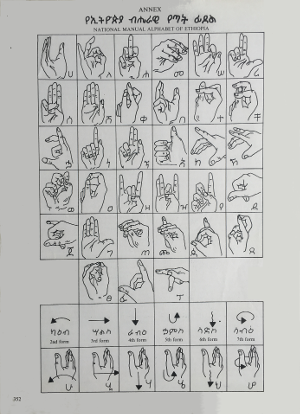
The Ethiopian Finger-spelling Alphabet
(Teklehaimanot Derso, "The Development of Gestual Communication
in Ethiopia", Proceedings of the 8th World Congress of the World
Federation of the Deaf, Bulgarian Deaf Union 1981, page 352)
This is what has been and still is in use since 1975.
Execution of the signs is as seen by the signer.
(Click on image for a bigger view)
Ethiopia is the only African country that has its own writing alphabet. When the education of the deaf was introduced to Ethiopia by religious missionaries, they brought along sign languages that were in use in their own respective countries. The Latin alphabet was also being used for writing. While the English language was and still is in use in Ethiopia, Amharic is the working language of the country and students were learning it and writing was in Ethiopic.
But, deaf students were left out from learning Amharic. Mr. Minasse Abera and Mr. Hailu Yesuneh, who were once teachers at the Amha Desta School for the Deaf (now called Makanissa School for the Deaf), knew this first hand. So, Minasse came up with a system of finger spelling for the Ethiopic ("Ge'ez") alphabet. After perfecting his system, he shared his creation with the ENAD where upon a three person committee was established by Mr. Hailu Ysuneh, the chairman of the ENAD, to study the matter further. The members of the committee were Mr. Minasse Abera, Mr. Teklehaimanot Derso and Mr. Hailu Yesuneh. After the committee made some further refinements, the system for finger spelling the Ethiopic alphabet was accepted by the ENAD making it possible to finger spell Amharic words as well as words in other Ethiopian languages, such as Tigrigna, that are written using the Ethiopic Alphabet.
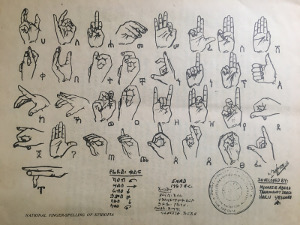
The National Finger-spelling of Ethiopian
the version that came out first in 1975 (1967 E.C.).
The official version that was distributed subsequently has the signs
for the characters "ሀ" and "በ" reversed.
(From 'Birtat'/Courage, ENAD's magazine, first issue, July 1976, page 18.
Click on image for a bigger view)
As developed originally, the signs for "ሀ / Ha" and "በ / Be" were reversed. However, during later revisions, it was decided to use the current form and that is what has been officially disseminated by the ENAD.
The Ethiopian National Association of the Deaf (ENAD) would like to inform all concerned that the official system of finger spelling alphabet in use in the country is the one that was published in the Proceedings of the 8th World Congress of the World Federation of the Deaf and shown above on this page.

Mr. Minasse Abera during the time he created
the Ethiopian Sign Language finger spelling
(Photo credit: Mr. Minasse Abera)
In the above listing, some alphabets have been missed. The first is the character "ቨ / Ve". The ENAD has included a sign for it in the Ethiopian Sign Language Dictionary, which is executed in identical manner to the sign for "በ / Be" but with the pinky finger raised up. Some members of the ENAD, particularly those who were involved in the creation of the finger spelling alphabet, were using a version that drops the middle finger from the sign for the character "በ". This version was a lot simpler to execute than the version that has been included in the dictionary. As a matter of fact, this sign exists in publications by the Hosana School for the Deaf and the Ethiopian Evangelical Church Mekane Yesus.

Mr. Minasse Abera demonstrating his creation.
This was before he submitted his system to the ENAD.
(Photo credit: Mr. Minasse Abera)
Another character is "ኧ". The logical thing to do would be to sign it like the character "አ" with the pinky finger raised. But, it will end in producing the ASL finger spelling for "Y" and might create confusion. The others are what are known as labiovelar, of which the most frequently encountered are the characters "ሏ", "ሟ", "ሯ", "ሷ", "ሿ", "ቋ", "ኋ", "ኳ", "ጓ" etc. Each of them could be finger spelled by using the finger spelling of two characters. For example, to indicate "ቋ", use is made of the finger spellings for "ቁ" and "ዋ". However, the deaf community has come up with a simpler way of finger spelling them. This involves moving the base sign in a down to up direction, identical to the movement when making an all right mark on a paper. As an example for "ቋ", one would form the sign for "ቀ" and then make an all right mark with it on the air.
The character "ቐ" and its variants are not used in the Amharic language. So, it is also missing from the original creation. However, it is used extensively in the Tigrigna language. Those who need it are signing it with a sign identical to that for the character "ቀ" modified by a the pinky finger raised up from its closed position.
First Book on Ethiopian Sign Language
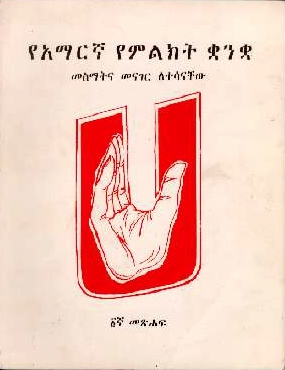
Cover of First book on Ethiopian Sign Language
Following the successful introduction of the national finger-spelling of Ethiopia, the ENAD pushed for the development of a national sign language system. Until then, the deaf were using combinations of American, Finnish and Swedish sign languages plus some home made signs. American Sign Language was mainly in use by the deaf in Addis Ababa while nordic sign languages were in use in Eritrea, which was then part of Ethiopia. It did not take long before deaf from Eritrea found themselves in Addis Ababa and they brought nordic signs with them.
Because of the close connection between languages and cultures, it was highly important for the deaf in Ethiopia to develop their own sign language. There were many words and concepts that do not exist in the west, for which we did not have signs then.
Following ENAD's request, a committee with members from the Ministry of Education, the Alpha School for the Deaf, the Makanissa School for the Deaf (which used to be known as the Amha Desta School for the Deaf) and the Ethiopian National Association of the Deaf (ENAD) was established. That was on 17 December 1975.
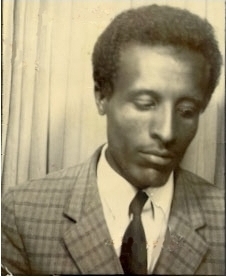
Mr. Hailu Yesuneh was the first chairman
of the ENAD and director of the ENAD office.
He managed the affairs of the ENAD ably
at a very difficult time and when nothing
much was known about the deafness and
the deaf in Ethiopia
(Photo credit: Mr. Hailu Yesuneh)
After a very hard work, the committee prepared some 1,009 signs and finished its work in August 1976. The ENAD was given the responsibility of editing and collating the signs including coordinating the art work with the artist, Mr. Alemseged Araya, who was a member of the ENAD. The task of editing and preparing the work for publication was very ably handled by Mr. Hailu Yesuneh, who was then the chairman of the ENAD and director of the ENAD office. The two schools shared the responsibility of paying Mr. Alemseged Araya who drew the signs. The Ministry of Education took the responsibility of getting the book printed.
Unfortunately, the printing of the book was delayed until 1978. The committee had agreed that the book was going to be distributed to the deaf free of charge. Sadly, that did not happen. Those responsible for the publication of the book argued that it was costly to print compared to other educational books for the hearing. That was so, because, two plates had to be prepared, one to print in black and the other to print in red. Thus, the ENAD was not able to get the book.
The title of the book translates to "Amharic Sign Language for the Deaf". This should not be taken to imply that there is such a thing as Amharic Sign Language. Prior to the publication of this book, the deaf had access to some books in American Sign Language. The description of the signs was in the English language. But, the descriptions in the new book on Ethiopian Sign Language was in Amharic. The reference to Amharic in the title of the book is to highlight that the description was in Amharic and accessible to many more who do not know English.
Ethiopian Sign Language Dictionary
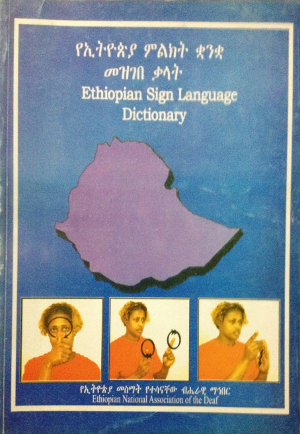
Cover of First Ethiopian Sign Language Dictionary
that was prepared & published with financial assistance
from the Finnish Association of the Deaf (FAD)
The Finnish Association of the Deaf (FAD) has been one of the best friends of the deaf in Eastern and Southern Africa region. It has been providing different types of trainings and seminars to the deaf that have contributed a lot towards empowering them.
The Second Eastern and Southern African Sign Language Seminar was held in Debrezeit, Ethiopia in 1991 and was organized by the ENAD with the financial support of the FAD and had brought deaf participants from five African countries countries. In terms of the ENAD receiving further assistance from Finland, that was a one shot even as Ethiopia was under the Derg regime at the time and some countries, including Finland, had policies that prevented them from providing assistance to the country, which they perceived was a communist country.

Page 5 of the first book on Ethiopian Sign Language
looked like the above in the new format.
By that time, the first book on Ethiopian Sign Language had gone out of circulation. As it became clear from our members, there was much demand for the book. So, one member of the original committee who had represented the ENAD in the preparation of the book and the chairperson of the ENAD decided to do some thing on the matter. They started work to produce an electronic format of the book. In the original work, the the transliteration of the signs was done only in Amharic. In the electronic version, they decided to also include Oromifa, Tigrigna and English.
After a few pages were ready, there was a seminar entitled "Our Future, Our Rights" that was organized by the FAD in Tanzania at which the Chairman of the ENAD also participated. He took printouts of the few pages and showed them to Dr. Liisa Kauppinen and asked her for help. By that time, the Derg's government had been replaced by the EPRDF government and there no longer existed any reason to prevent Western countries from cooperating with Ethiopia. So, the ENAD was very lucky in that the FAD accepted ENAD's request for help.
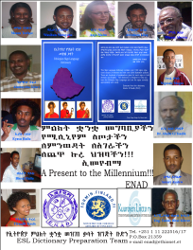
Poster that was distributed during the
inauguration of the dictionary showing
the members of ESL Dictionary
Preparation Team. The members of the
team are (clockwise from top left): Meazu
Tesfaye, Wassihun Sintayehu, Anja Malm,
Abraham Lilay, Minasse Abera, Negussie
Moges, Dr. Abebe G/Tsadik, Amare Ayalew,
Eng. Tadele Bitul Kibrat, Tiruedil Terefe,
Bisrat Hailu, Eyasu Hailu and Alemayehu
Teferi (Photo credit: ENAD)
(Click on photo for a bigger image)
Thus started a very fruitful cooperative work between the ENAD and FAD. Ever since that time, the FAD has been very actively supporting the ongoing work of the ENAD including the development of Ethiopian Sign Language, for which the deaf in Ethiopia are very grateful.
The Ethiopian National Association of the Deaf (ENAD) has published an Ethiopian Sign Language Dictionary. This publication was made possible through the cooperation of the Finnish Association of the Deaf (FAD), which provided the necessary funds for researching, collection and collation of the signs and for publishing of the book.
